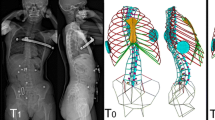Abstract
As part of the development of new modelling tools for the simulation and design of brace treatment of scoliosis, a finite element model of a brace and its interface with the torso was proposed. The model was adapted to represent one scoliotic adolescent girl treated with a Boston brace. The 3D geometry was acquired using multiview radiographs. The model included the osseo-ligamentous structures, thoracic and abdominal soft tissues, brace foam and shell, and brace-torso interface. The simulations consisted of brace opening to include the patient's trunk followed by brace closing. To validate the model, the resulting geometry was compared with the real in-brace geometry, and the resulting contact reaction forces at the brace-torso interface were compared with the equivalent forces calculated from pressure measurements made on the in-brace patient. Differences between coronal equivalent and reaction forces were less than 7N. However, sagittal reaction forces (47N) were computed on the abdomen, whereas negligible equivalent forces were measured. The simulated geometry presented partially reduced coronal Cobb angles (1–40), over-corrected sagittal Cobb angles and maximum deformation plane (50), completely corrected coronal shift, and sagittal shift and rib humps that were not corrected. This study demonstrated the feasibility of a new approach that represents the load transfer from the brace to the spine more realistically than does the direct application of forces.
Similar content being viewed by others
References
Andriacchi, T. P., Schultz, A. B., Belytschko, T., andDewald, R. L. (1976): ‘Milwaukee brace correction of idiopathic scoliosis’,J. Bone Joint Surg.,58A, pp. 806–815
Aubin, C. É., Dansereau, J., andLabelle, H. (1993): ‘Biomechanical simulation of the effect of the Boston brace on a model of the scoliotic spine and thorax (in French)’,Ann. Chir.,47, pp. 881–887
Aubin, C. E., Descrimes, J. L., Dansereau, J., Skalli, W., Lavaste, F., andLabelle, H. (1995): ‘Geometrical modeling of the spine and thorax for biomechanical analysis of scoliotic deformities using finite element method (in French)’,Ann. Chir.,49, pp. 749–761
Bischoff, J. E., Arruda, E. M., andGrosh, K. (2000): ‘Finite element modeling of human skin using an isotropic, nonlinear elastic constitutive model’,J. Biomech.,33, pp. 645–652
Dansereau, J., Côté, B., Labelle, H., andAubin, C.-É., (1992): ‘Measurement of forces generated by Boston brace in the treatment of scoliotic deformities’,J. Biomech.,25, p. 656
Delorme, S., Petit, Y., de Guise, J., Labelle, H., Aubin, C. É., andBansereau, J. (2003): ‘Assessment of the 3D reconstruction and high-resolution geometrical modeling of the human skeletal trunk from 2D radiographic images’,IEEE Tr. Biomed. Eng.,50, pp. 989–998
Descrimes, J. L., Aubin, C. É., Skalli, W., Zeller, R., Dansereau, J., andLavaste, F. (1995): ‘Introduction des facettes articulaires dans une modélisation par éléments finis de la colonne vertébrale et du thorax scoliotique: aspects mécaniques’,Rachis,7, pp. 301–314
Dietrich, M., Hedzior, K., andZagrajek, T. (1991): ‘A biomechanical model of the human spinal system’,Proc. Instn. Mech. Eng.,205, pp. 19–26
Gignac, D., Aubin, C. E., Dansereau, J., andLabelle, H. (2000): ‘Optimization method for 3-D bracing correction of scoliosis using a finite element model’,Eur. Spine J.,9, pp. 185–190
Jiang, H., Raso, W., Hill, D., Durdle, N., andMoreau, M. (1992): ‘Interface pressure in the Boston brace treatment for scoliosis: a preliminary study’. Int. Symposium on 3D Scoliotic Deformities (Editions de l'Ecole Polytechnique, Montréal, and Gustav Fischer Verlag, Stuttgart), pp. 395–399
Labelle, H., Dansereau, J., Bellefleur, C., andPoitras, B. (1996): ‘Three-dimensional effect of the Boston brace on the thoracic spine and the rib cage’,Spine,21, pp. 59–64
Mac-Thiong, J. M., Petit, Y., Delorme, S., Dansereau, J., Aubin, C. É., andLabelle, H. (2004): ‘Biomechanical evaluation of the Boston brace for the treatment of AIS: relationship between strap tension and brace pressure interface’.Spine,29, pp. 26–32
Marras, W. S., andSommerich, C. M. (1991): ‘A three-dimensional motion model of loads on the lumbar spine: I. Model structure’,Hum. Factors,33, pp. 123–137
Odermatt, D., Mathieu, P. A., Beauséjour, M., Labelle, H., andAubin, C. E. (2003): ‘Electromyographic study of adolescent idiopathic scoliosis patients treated with the Boston brace’,J. Orthop. Res. 21, pp. 931–936
Ogilvie, J. (1994):Weinstein, S. L. (Ed.): ‘Spinal orthotics. An Overview, the Pediatric Spine: Principles and Practice’ (Raven Press Ltd., New York, USA, 1994), pp. 1787–1793
Patwardan, A. G., Bunch, W. H., Meade, K. P., Vanderby, R. J., andKnight, G. W. (1986): ‘A biomechanical analog of curve progression and orthotic stabilization in idiopathic scoliosis’,J. Biomech.,19, pp. 103–117
Périé, D., Sales de Gauzy, J., andHobatho, M. C. (2002): ‘Biomechanical evaluation of Cheneau-Toulouse-Munster brace in the treatment of scoliosis using optimisation approach and finite element method’,Med. Biol. Eng. Comput.,40, pp. 296–301
Périé, D., Aubin, C. E., Petit, Y., Beauséjour, M., Dansereau, J. andLabelle, H. (2003): ‘Boston brace correction in idiopathic scoliosis: A biomechanical study’,Spine,28, pp. 1672–1677
Petit, Y., Aubin, C. E., Dansereau, J., Gignac, D., Joncas, J., de Guise, J. A., andLabelle, H. (1998): ‘Effect of strap tension on the pressure generated by the Boston brace on idiopathic scoliosis patients: a preliminary study’,J. Biomech.,31, p., 175
Stokes, I. A. (1994): ‘Three-dimensional terminology of spinal deformity. A report presented to the Scoliosis Research Society by the Scoliosis Research Society. Working Group on 3-D terminology of spinal deformity’,Spine,15 pp. 236–248
Sundaram, S. H., andFeng, C. C. (1977): ‘Finite element analysis of the human thorax’,J. Biomech.,10, pp. 505–516
Ueyoshi, A., andShima, Y. (1985): ‘Studies on spinal braces, with special reference to the effects on increased abdominal pressure’,Int. Orthop.,9, pp. 255–258
Wynarsky, G. T., andSchultz, A. B. (1991): ‘Optimization of skeletal configuration: studies of scoliosis correction biomechanics’,J. Biomech.,24, pp. 721–732
Author information
Authors and Affiliations
Corresponding author
Rights and permissions
About this article
Cite this article
Périé, D., Aubin, C.E., Lacroix, M. et al. Biomechanical modelling of orthotic treatment of the scoliotic spine including a detailed representation of the brace-torso interface. Med. Biol. Eng. Comput. 42, 339–344 (2004). https://doi.org/10.1007/BF02344709
Received:
Accepted:
Issue Date:
DOI: https://doi.org/10.1007/BF02344709




